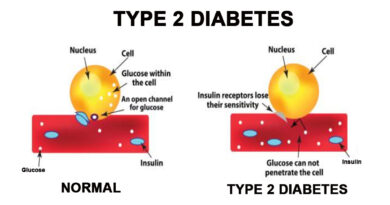What do I Need to Know About Diabetes?
Diabetes is a disease that occurs when your blood glucose is too high. Excess glucose in the bloodstream doesn’t get into the cells and muscle tissue of the body where it acts as fuel to be burned as energy. Diabetics often find themselves sluggish and tired.
In order to get into the cells, glucose must have both insulin and GTF (Glucose Tolerance
Factor). Insulin acts as a key. It opens the cell “door” so glucose can get in where it can be stored and used as energy. Insulin is generated by the beta cells of the pancreas. Under normal conditions the pancreas produces just enough insulin to get the job done. Insulin production occurs shortly after eating. Things are different for the diabetic.
The food you eat is turned into glucose. How much depends on the type of food and how much you eat. A meal high in simple carbohydrates will lead to a sharp rise in blood sugar. Complex carbohydrates take longer to be converted into glucose. The pancreas kicks in to produce insulin so the excess sugar can be shuttled into the muscle and other cells of the body for future storage and the be used as energy.
There are two types of diabetics. In type 1, the pancreas does not produce enough insulin to get that glucose into the cells. With little insulin to shuttle excess glucose into the cells, glucose stays in the bloodstream where it builds up to dangerous levels and begins to wreck havoc on the organs. Type 1 is usually prevalent in the early years and usually strikes children and young adults.
The reason why the pancreas does not do the job of producing insulin is unclear, though it is assumed that the pancreas becomes damaged or is attacked by the body’s own immune system. Cancer of the pancreas can contribute to a lack of insulin, though this condition is rare in children. Yet another reason is due to burnout which results to overproduction of insulin and eventual burnout of the pancreas.
Check out these related articles, too:
Juice and The Effect It Has On Your Blood Sugar
SUPERFOODS FOR BLOOD SUGAR CONTROL
Almonds The Ultimate Diabetes Superfood
How to Lower High Blood Sugar With Diabetes Herbal Remedies
How To Know If You Have The Symptoms Of Low Blood Sugar
What level of blood sugar is dangerous?
What Does High Blood Sugar Feel Like?
Whatever the reason, Type 1 diabetics require insulin shots to do the job the pancreas cannot perform. They need to take insulin before every meal to control their blood sugar and require it for the rest of their lives. Only 5% of diabetics fall into the Type 1 category.
The majority of diabetics are Type 2. They have healthy pancreas that generates adequate amounts of insulin, but the insulin is not able to “open the door” of the cells so glucose can enter. To compensate, the pancreas produces more insulin to get the job done. But often the cells become resistant to insulin-they simply don’t open up. This situation make the pancreas produce even more insulin. Eventually, the pancreas cannot produce any more and burns itself out. Type 2 diabetics have no lack of insulin. The cells just don’t recognize insulin.
The reason for this insulin resistance is due to the fact that most type 2 diabetics are overweight
and obese. Fully 90% of Type 2 diabetics are overweight or obese. It has been shown that fat around
the abdominal region acts like a separate organ, producing compounds which can make cells resistant. Excess fat interferes with the functioning of the cells. Just by shedding a few pounds, you can better manage your blood sugar levels. Of course weight loss is not the only solution. Besides excess weight a sedentary lifestyle aggravates the problem. The cells need oxygen and the proper nutrients that make them elastic and better able to take in glucose. The proper amount of exercise helps them do the job.
The human body is made to be active. Without some kind of activity whether it’s as simple as
walking, cooking or cleaning, cells can’t function. A diet of highly refined and processed food loaded with fat and sugar makes up the standard fare of most everyone, but does little to help those cells.
Diabetes rates a close third behind heart disease and cancer. Many of the food you buy come
loaded with fat, sugar and salt and has little essential fiber like that of our early ancestors. It’s the lack of the right nourishment that is leading the world to the epidemic of diabetes.
Malnutrition in America Our store shelves are stocked with an endless variety in taste, texture, sweetness and packaging.
Deliciously Simple Breakfast Ideas for Diabetics
Diabetes and the Paleolithic Diet
Skin Problems Connected to Diabetes
What is the biggest contributor to diabetes?
Diabetes Foods to Eat – You Have a Lot to Eat Without Fear
Amazing Diabetics Breakfast Ideas
10 Diabetic Foods to Avoid for Blood Sugar Control
With so much food available it’s hard to believe that many Americans are malnourished. While we
sympathize with the poor in countries where food is scarce, we don’t realize that famine can strike
anywhere, even in the richest nations on Earth. We don’t need to be undernourished to suffer from
malnutrition which is just another form of famine.
We grow enough food to feed ourselves and throw away enough food to feed 50 million people
every day. There’s enough food in storage to feed us all for a year if our nation’s farmers decided to stop growing food.
Despite this food wealth, we are seeing a rapid rise in degenerative diseases around the world.
As more nations adopt the Western-style diet, we see more diabetics where there once were few of
them. All of this, it has been established, has been brought about by the poor choices of the food we eat. Taste, cost, convenience and gratification is the primary concern. But those choices do not provide the right kind of nourishment for health. White bread, coffee, beer, hot dogs and soft drinks are the primary food and drink consumed. Just take a look at this list of popular grocery items purchased in America today:
● Coke Classic
● Cigarettes; Marlboro and Winston
● Kraft processed cheese
● Pepsi
● Diet Coke
● Campbell Soup
● Budweiser beer
● Tide Detergent
● Folger’s Coffee
● White bread
Nowhere on this list do you find fruits, vegetables or whole grain cereal. A study done by the
U.S. Department of Agriculture of over 11,000 Americans showed that:
● 41% ate no fruit
● 82% ate no cruciferous vegetables (broccoli, spinach and the like)
● 72% ate no vitamin C rich fruits and vegetables
● 80% ate no vitamin A rich fruits and vegetables
● 84% ate no high fiber grain food.
Not an impressive list of food items. If the trend continues, America will destroy itself before
any enemy could choose to invade it.
America spends some 1.5 trillion dollars in medical care, more than any other nation and yet
ranks among the highest in sickness and disease! Americans are woefully low in Vitamins A, C, D, E,
K, B-6, riboflavin, folate and lack the essential minerals of calcium, potassium, magnesium, zinc, iron, chromium and selenium. Fiber from plant proteins, special fatty acids and complex carbohydrates are lacking in our diet. Fat, sugar, alcohol, caffeine, cholesterol, food additives and toxins from the environment combine to the health woes we see around us today. With so many poor choices it’s not surprising that we are faced with so many diseases, all of which could easily be prevented.
If we suddenly keeled over into a diabetic coma after the first sugar spike, most of us would
scramble to make changes in our habits. Unfortunately it takes years of an unhealthy lifestyle before symptoms start to show up. The first cigarette won’t kill you, neither will that first hamburger. But constant habits is what translates into heart disease and diabetes.
While we live in expensive homes, drive the latest model car and own the latest electronic
gadgets, disease of any kind won’t allow us to enjoy it all. Clearly a lifestyle change is necessary, but few people have the self-discipline to make those changes.




